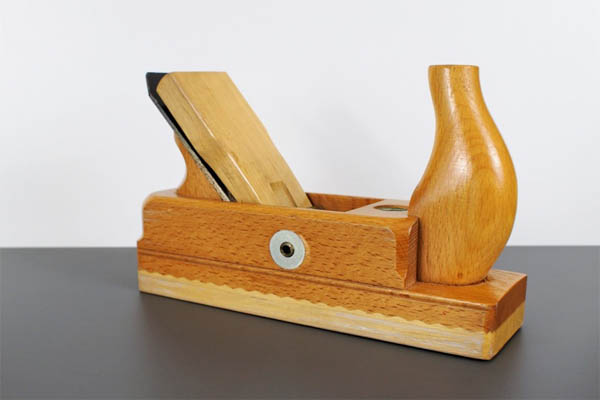Planes: Crucial Implements for Woodworking
Plane is a hand tool specifically designed for shaping, smoothing, and refining wooden surfaces. It consists of a sharp blade, often referred to as an iron, that is set at an angle to a flat base or sole.
This blade extends through an opening in the sole and can be adjusted to control the depth of cut.
When the plane is pushed or pulled across a wooden workpiece, the blade shaves off thin layers of wood, resulting in a smoother and more even surface.
Woodworking planes are used for various tasks such as flattening, smoothing, dimensioning, and creating specific profiles or edges on wood.
They come in different types, each suited for particular woodworking applications.
Types of Woodworking Planes
Woodworking planes come in various forms, each tailored to specific tasks:
1.) Bench Planes
- Smoothing Plane: For achieving a glass-smooth finish on wood surfaces.
- Jack Plane: Ideal for removing rough stock quickly and preparing boards for further work.
- Jointer Plane: Used to straighten and flatten the edges of boards and create perfect joints.
- Fore Plane: A middle-ground plane, versatile for a range of smoothing and leveling tasks.
- Scrub Plane: Designed for aggressive stock removal and leveling rough boards.
2.) Block Planes
These compact planes are perfect for one-handed use and precision work.
Specialty Planes
- Router Plane: Excels in hollowing out areas or dadoes in wood.
- Shoulder Plane: Ideal for fine-tuning shoulders and rebates in joinery.
- Rabbet Plane: Used to create clean rabbets or rebates along the edge of a board.
- Plough Plane: Perfect for cutting grooves and dadoes, especially in panel work.
- Compass Plane: Handy for working curved or uneven surfaces.
- Spokeshave: Essential for shaping curved and contoured surfaces.
- Electric Hand Planers: Modern electric counterparts to hand planes for efficiency.
Choosing the right plane for the job depends on factors like wood type and desired outcome.
Anatomy of a Woodworking Plane
Understanding a plane’s anatomy is crucial for its proper use:
- Body (Frog and Sole): The main frame of the plane that houses the blade.
- Blade (Iron): The sharp, cutting edge responsible for shaping the wood.
- Chip Breaker (Cap Iron): Sits atop the blade, helping to control wood chips.
- Lever Cap: Holds the blade and chip breaker securely in place.
- Tote and Knob (Handles): Allow for a comfortable and firm grip.
- Adjusting Mechanisms (Depth and Lateral Adjustments): Enable precise control over the blade’s depth and angle.
- Mouth (Throat): The opening through which the blade protrudes, affecting the plane’s performance.
Common Uses of Woodworking Planes
Woodworking planes are incredibly versatile and find applications in various tasks:
- Surface Smoothing: Achieving a polished, flawless finish.
- Thicknessing and Dimensioning: Preparing boards to the desired thickness and size.
- Jointing and Edge Planing: Ensuring perfect edges and joints.
- Creating Rabbets and Rebates: Forming clean, well-defined edges and recesses.
- Shaping and Chamfering: Sculpting wood into intricate shapes and adding decorative edges.
- Specialty Applications: Addressing unique challenges in woodworking projects.
Proper Usage and Safety of Woodworking Planes
To maximize the benefits of a woodworking plane and ensure safety, follow these guidelines:
- Select the Right Plane: Choose a plane that suits your specific woodworking task.
- Prepare the Plane: Ensure the blade is sharp and properly set.
- Setting Adjustments: Adjust the depth and lateral settings to achieve the desired results.
- Maintain Consistency: Keep a consistent angle and pressure during use.
- Secure Grip: Hold the plane firmly and comfortably to prevent accidents.
- Safety Precautions: Wear appropriate protective gear and maintain a safe workspace.
- Proper Plane Storage: Store your planes securely to prevent damage and ensure longevity.
Maintenance and Care of Woodworking Planes
Preserve the longevity and performance of your planes with proper care:
- Cleaning and Oiling: Keep the plane clean and well-oiled to prevent rust.
- Blade Sharpening and Honing: Regularly sharpen and hone the blade for optimal cutting.
- Adjusting and Tuning: Periodically check and adjust the plane’s components.
- Replacing Blades and Parts: Replace worn-out or damaged components promptly.
- Rust Prevention: Protect your planes from moisture and rust.
Conclusion
In the world of woodworking, planes are not mere tools; they are the extension of a craftsman’s vision and skill.
These timeless instruments have been at the heart of craftsmanship for generations, shaping wood into works of art.
Understanding the various types, the anatomy, proper usage, safety, and maintenance of woodworking planes is the key to unlocking their full potential.
Whether you’re a professional woodworker or an enthusiastic DIYer, the humble plane remains a symbol of craftsmanship’s enduring legacy.

Don Kerr spent many years honing his skills as a DIY woodworker. He finds immense joy in not only creating remarkable pieces but also in generously sharing his knowledge. Connect with him via group.



